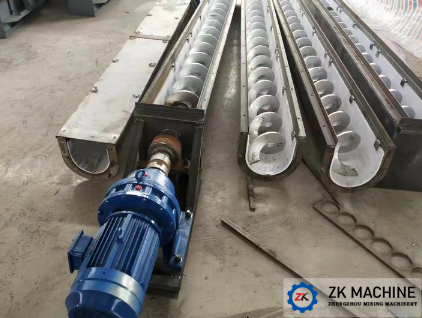Screw conveyor is a mechanical device that uses a motor to drive the spiral blade to rotate, thereby pushing the material to achieve transportation. It can be transported horizontally, inclined or vertically, and has the characteristics of simple structure, small cross-sectional area, good sealing, convenient operation and easy maintenance. Screw conveyors are divided into two types in terms of conveying form: shaft screw conveyors and shaftless screw conveyors, and in terms of appearance, they are divided into U-shaped screw conveyors and tubular screw conveyors. Shaft screw conveyors are suitable for non-sticky dry powder materials and small particle materials, while shaftless screw conveyors are suitable for conveying sticky and easily entangled materials.

1. Development History
The development of screw conveyors has gone through the evolution of two types: shaft screw conveyors and shaftless screw conveyors. The shaft screw conveyor is composed of a screw, a U-shaped trough, a cover plate, an inlet and outlet, and a drive device, while the shaftless screw conveyor uses a screw instead of a shaftless screw, and a replaceable liner is installed in the U-shaped trough. The structure is simple, and the material is input from the inlet and output from the outlet after being pushed by the screw. The entire transmission process can be carried out in a sealed trough.
2. Technical features
The technical features of screw conveyors include simple structure, low cost, reliable operation, easy maintenance and management, compact size, small cross-sectional size, sealed conveying, convenient loading and unloading, and reverse conveying. However, its unit energy consumption is large, and the material is easy to be crushed and worn during the conveying process, and the wear of the spiral blades and the trough is also serious.
3. Structural composition
The screw conveyor consists of a coupling, inlet and outlet, a main shaft device, a bearing seat assembly, an intermediate bearing, a bottom frame assembly, legs and a drive. The screw conveyor body is assembled from spiral blades, a trough body and a main shaft device. The drive device is a motor and a reducer.
4. Development Trend
With the advancement of science and technology, the design and manufacturing technology of screw conveyors continue to improve, and new screw conveyors have made significant improvements in efficiency, energy saving, and environmental protection. For example, some new screw conveyors adopt efficient drive systems and advanced control technology to improve conveying efficiency and reduce energy consumption. In addition, some screw conveyors are also equipped with intelligent monitoring systems, which can monitor the operating status of the equipment in real time, detect and deal with potential faults in a timely manner, and ensure the stable operation of the equipment.




















